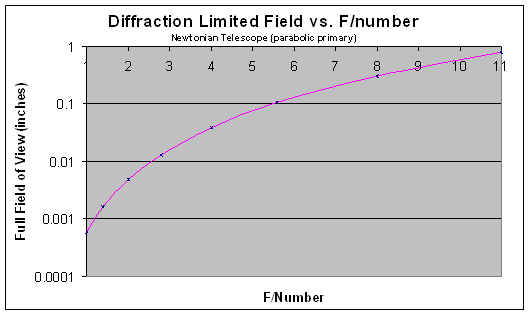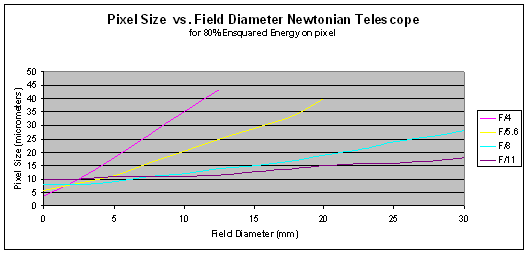
The Newtonian Telescope as an Astrograph
Dave Erickson © 2008
The ever popular Newtonian telescope is an elegant design in its simplicity. With a parabolic primary mirror and smaller flat secondary the Newtonian makes a wonderful visual instrument. A well corrected parabola will make perfect images when used near the optical axis, and for narrow fields the Newtonian telescope provides spectacular diffraction limited views. Despite its severe performance limitations as an astrograph there is no doubt that many spectacular astronomical images have been made using Newtonian telescopes.
The performance of a Newtonian degrades as stars become more comatic with increasing distance off axis. This performance degradation is a strong function of F-number and for very fast systems the Newtonian has an exceedingly small diffraction limited field. The graph below plots the diffraction limited field for Newtonian systems from a blazing fast F/1 to a rather slow F/11 system. Notice that at F/1 the diffraction limited field is <0.001” in diameter while at F/11 it is nearly 1” in diameter. It is evident from this graph why owners of fast Newtonians become experts at collimation.

An interesting attribute of the Newtonian is its useful image diameter is independent of aperture. That is a 200” aperture F/3 Newtonian has the same useful image diameter as an 8” F/3 Newtonian. Of course the angular field of view for the two systems is significantly different.
Not to many years ago the measure of a good astrograph was defined by the limiting properties of photographic film. One such limiting property of film is the scattering light as it transmits deeper into the photographic emulsion. This light scattering creates an exposed image more diffuse than what would have otherwise been created by a perfect optical system. For stellar objects this scattering increases the minimum star diameter and correspondingly limits the minimum resolvable object. For most photographic film the minimum recordable stellar object is between 0.025mm for under exposed images to 0.100mm for over exposed images. An astrograph with aberrations contained within 0.050mm blur when used with film was considered acceptable. A criterion for designing photographic film based systems is the reduction of image blurs to the range of between 0.025mm and 0.050mm.
For a full frame 35mm format film based systems faster than about F/6 will show significant aberrations at the field edges. It is interesting to note that Kodak Technical Pan Film has somewhat higher performance of >50% modulation at 50 lp/mm, and makes the limits of a fast Newtonian more pronounced.
CCD imagers are considerably more demanding than their film predecessors. With CCD and CMOS sensors it is possible to collect a majority of the light from a star in a single pixel, and using a fast astrograph with small diffraction spots the pixels can be correspondingly small. Recall that the diameter of the first dark diffraction ring for a stellar image is 2.44 l F#.
The graph below plots useful field diameter as a function of pixel size for various Newtonian astrograph focal ratios. Useful here is collection of 80% of a stars energy in a single pixel. This criteria under samples a star and keeps it from having that bloated look.

Notice that by this definition the useful field of a Newtonian telescope, using a camera with 10micrometer pixels, is less that 2.5mm for an F/4 system.
Ok we have all seen some very nice images made by Newtonian systems performing well outside this criteria, the point is there is plenty of room for improvement. Newtonian telescopes in their simplest form are not the optimal choice for astronomical imaging.